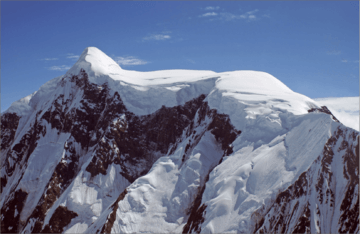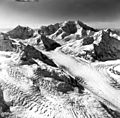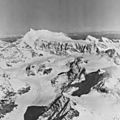Mount Bertha facts for kids
Quick facts for kids Mount Bertha |
|
|---|---|

Bertha's summit detail, from northwest
|
|
| Highest point | |
| Elevation | 10,204 ft (3,110 m) |
| Prominence | 3,454 ft (1,053 m) |
| Parent peak | Mount Crillon (12,726 ft) |
| Geography | |
| Location | Glacier Bay National Park Hoonah-Angoon Alaska, United States |
| Parent range | Fairweather Range Saint Elias Mountains |
| Topo map | USGS Mount Fairweather C-4 |
| Climbing | |
| First ascent | July 30, 1940 Bradford Washburn |
| Easiest route | Mountaineering |
Mount Bertha is a tall, icy mountain in the Fairweather Range of the Saint Elias Mountains in southeast Alaska, United States. It stands at 10,204 feet (3,110 meters) high. This impressive peak is located inside Glacier Bay National Park.
Mount Bertha is about 5.5 miles (9 km) east of Mount Crillon, which is a bit taller. It's also about 23.5 miles (38 km) southeast of Mount Fairweather, the highest mountain in the Fairweather Range.
Contents
How Did Mount Bertha Get Its Name?
The name "Mount Bertha" first appeared on maps in 1910. The USGS says the mountain was named after a ship called the S.S. Bertha. This ship belonged to the Alaska Commercial Company and was used from 1888 until it sank in 1915.
Who Climbed Mount Bertha First?
The first time anyone successfully climbed to the top of Mount Bertha was on July 30, 1940. A team of five climbers made this historic ascent. The team included Bradford Washburn, his wife Barbara Washburn, Maynard Miller, Michl Feuersinger, and Thomas Winship.
This climb was Barbara Washburn's very first experience with mountain climbing. Bradford Washburn later joked that the trip was their honeymoon, as they had just gotten married in April. After this amazing adventure, Barbara found out she was expecting a baby. Years later, in 1947, she became the first woman to reach the summit of Denali, North America's highest peak!
What is the Weather Like on Mount Bertha?
Mount Bertha has a subarctic climate. This means it has very cold, snowy winters and mild summers. The weather systems coming from the Gulf of Alaska hit the Fairweather Range. This causes a lot of rain and snow to fall on the mountains.
Temperatures can drop really low, sometimes below -20 °C. With the wind, it can feel even colder, below -30 °C! Because of this cold climate, you can see large glaciers on Mount Bertha's slopes. These include the huge Brady Glacier to the south, the Reid Glacier to the northeast, and the Johns Hopkins Glacier to the northwest.
The water from melting glaciers and rainfall flows into Glacier Bay and then into the Gulf of Alaska. If you want to climb Mount Bertha or just enjoy the views, the best time to visit is usually from May through June. The weather is most favorable then.
Images for kids







